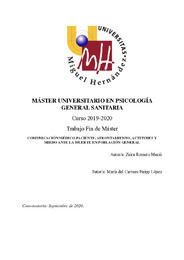Por favor, use este identificador para citar o enlazar este ítem:
https://hdl.handle.net/11000/27706Registro completo de metadatos
| Campo DC | Valor | Lengua/Idioma |
|---|---|---|
| dc.contributor.advisor | Neipp López, María del Carmen | - |
| dc.contributor.author | Romero Maciá, Zaira | - |
| dc.contributor.other | Departamentos de la UMH::Psicología de la Salud | es_ES |
| dc.date.accessioned | 2022-09-26T11:29:47Z | - |
| dc.date.available | 2022-09-26T11:29:47Z | - |
| dc.date.created | 2020-09-18 | - |
| dc.identifier.uri | https://hdl.handle.net/11000/27706 | - |
| dc.description.abstract | Introducción. La problemática de la muerte sigue vigente en nuestros días en los que vivimos desligados de ella, temiendo y haciendo tabú dicho proceso. Se pretende saber el nivel de información sobre el final de vida que los sujetos poseen, así como intentar relacionar el dicho nivel de información con la satisfacción medico-paciente además de ver las diferencias entre sexos de las variables actitudes, miedo y afrontamiento de la muerte.Método. Se utilizarán el Perfil Actitudes ante la Muerte-Revisado, el Cuestionario Relación Médico-Paciente, la Escala de Afrontamiento de la Muerte y la Escala Miedo a la Muerte de Collette-Lester y un pequeño cuestionario con preguntas abiertas. En el presente estudio comparativo, se ha analizado un total de 60 sujetos, 17 hombres y 43 mujeres a fin de apreciar diferencias entre los diferentes instrumentos utilizados, filtrando por sexo y edad. Resultados. Los participantes muestran un afrontamiento medio de 133.60, las principales actitudes son Aceptación de Acercamiento, Aceptación Neutral y Miedo a la Muerte, lo que más temen es la Muerte de Otros, el Proceso de Morir de Otros y el Tu Propio Proceso de Morir. Discusión. Los resultados son en parte parejos a los dados por otros autores, se considera que la información de los sujetos es escasa y que se debe apostar por iniciativas que acercan más a la población a reflexionar en la muerte. | es_ES |
| dc.description.abstract | Introduction. Nowadays the death problematic is valid. We live disconnected from it, fearing it and making it taboo. It is intended to know the level of information about the end of life that the subjects have, as well as to try to relate the said level of information with the doctor-patient satisfaction in addition to seeing the differences between the sexes of the variables attitudes, fear and coping with death. Method. The Revised Profile of Attitudes towards Death-, the Patient-Doctor Relationship Questionnaire, the Coping with Death Scale and the Collette-Lester Fear of Death Scale and a small questionnaire with open questions will be used. In this comparative study, a total of 60 subjects, 17 men and 43 women, have been analyzed in order to appreciate differences between the different instruments used, filtering by sex and age. Results. The participants show an average coping of 133.40, the main attitudes are Approach Acceptance, Neutral Acceptance and Fear of Death, what they fear the most is the Death of Others, the Dying Process of Others and The Own Dying Process. Discussion. The results are in part similar to those given by other authors, it is considered that the information of the subjects is scarce and that it is necessary to bet on initiatives that bring the population closer to reflecting on death. | es_ES |
| dc.format | application/pdf | es_ES |
| dc.format.extent | 69 | es_ES |
| dc.language.iso | spa | es_ES |
| dc.publisher | Universidad Miguel Hernández de Elche | es_ES |
| dc.rights | info:eu-repo/semantics/openAccess | es_ES |
| dc.rights | Attribution-NonCommercial-NoDerivatives 4.0 Internacional | * |
| dc.rights.uri | http://creativecommons.org/licenses/by-nc-nd/4.0/ | * |
| dc.subject | población general | es_ES |
| dc.subject | afrontamiento | es_ES |
| dc.subject | actitudes | es_ES |
| dc.subject | miedo | es_ES |
| dc.subject | muerte | es_ES |
| dc.subject.other | CDU::1 - Filosofía y psicología::159.9 - Psicología | es_ES |
| dc.title | Comunicación médico-paciente, afrontamiento, actitudes y miedo ante la muerte en población general | es_ES |
| dc.type | info:eu-repo/semantics/masterThesis | es_ES |

Ver/Abrir:
ROMERO_MACIA_Zaira_TFM.pdf
598,24 kB
Adobe PDF
Compartir:
 La licencia se describe como: Atribución-NonComercial-NoDerivada 4.0 Internacional.
La licencia se describe como: Atribución-NonComercial-NoDerivada 4.0 Internacional.
.png)